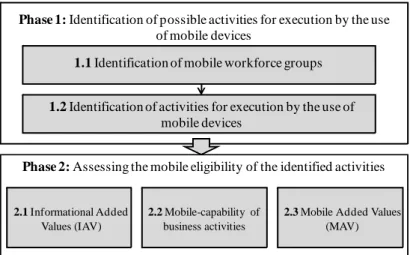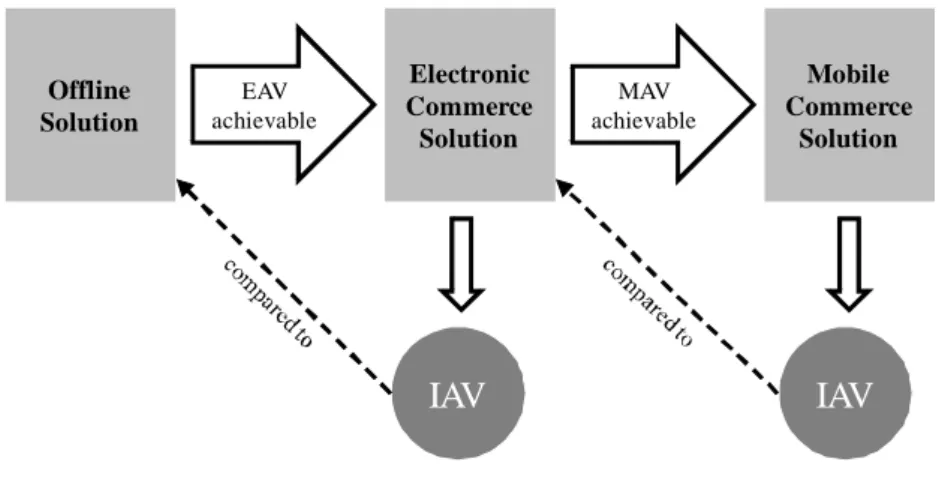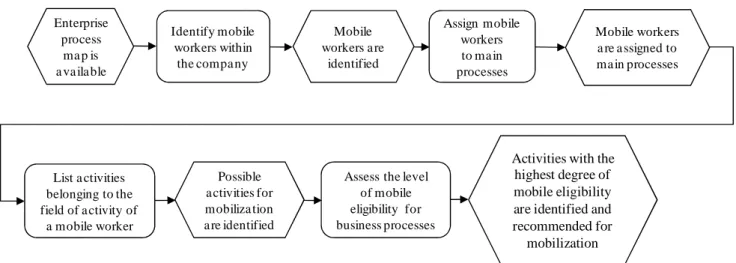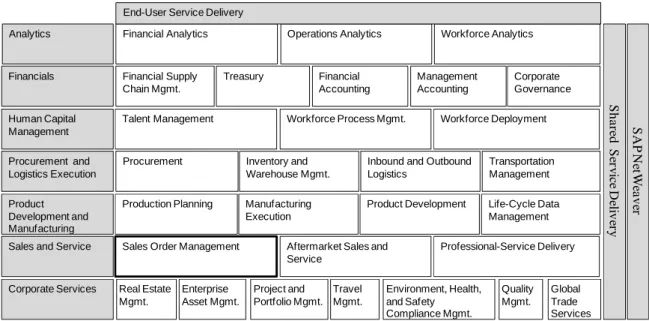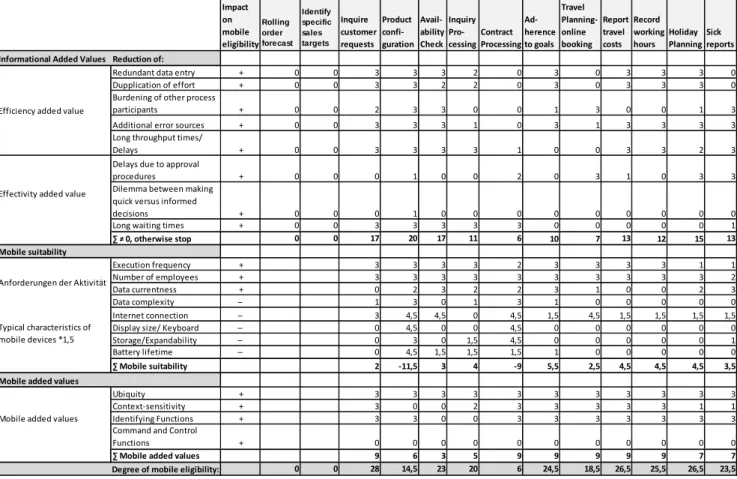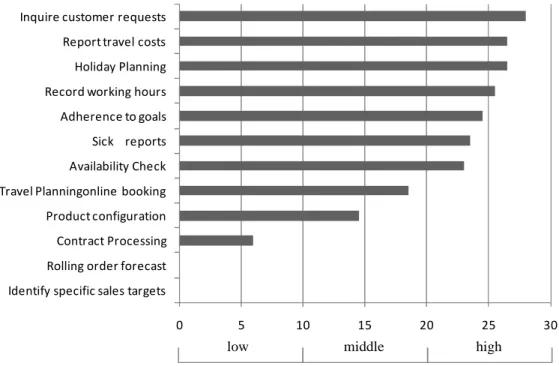AIS Electronic Library (AISeL)
AMCIS 2011 Proceedings - All Submissions
8-6-2011
Towards an Approach to Identify and Assess the
Mobile Eligibility of Business Processes
Vassilena Mladenova
Technische Universität München, vassilena.mladenova@in.tum.de
Marcus Homann
Technische Universität München, marcus.homann@in.tum.de
Harald Kienegger
Technische Universität München, harald.kienegger@in.tum.de
Holger Wittges
Technische Universität München, holger.wittges@in.tum.de
Helmut Krcmar
Technische Universität München, krcmar@in.tum.de
Follow this and additional works at:
http://aisel.aisnet.org/amcis2011_submissions
Recommended Citation
Vassilena Mladenova; Homann, Marcus; Kienegger, Harald; Wittges, Holger; and Krcmar, Helmut, "Towards an Approach to Identify and Assess the Mobile Eligibility of Business Processes" (2011).AMCIS 2011 Proceedings - All Submissions. 264.
Towards an Approach to Identify and Assess the
Mobile Eligibility of Business Processes
Vassilena Mladenova
Technische Universität München
vassilena.mladenova@in.tum.de
Marcus Homann
Technische Universität München
marcus.homann@in.tum.de
Harald Kienegger
Technische Universität München
harald.kienegger@in.tum.de
Holger Wittges
Technische Universität München
holger.wittges@in.tum.de
Helmut Krcmar
Technische Universität München
krcmar@in.tum.de
ABSTRACT
So far, the discussion about the usage of mobile devices in companies was strongly technology driven. However, current mo-bile devices and related momo-bile networks have reached a high level of maturity. For this reason, technological issues are no longer obstacles for using mobile devices within companies’ business processes. From our perspective, identifying business process activities, which can be improved by mobile device support, is currently rather important. The degree of suitability of business processes for mobile device support is called the mobile eligibility of a business process. Aim of this paper is to present an approach that supports the systematic analysis and assessment of the mobile eligibility of business processes, tak-ing into account a set of structured, adaptable criteria to deliberate between potential business values added by mobile devices and the typical mobile device characteristics.
KEYWORDS
Business processes, activities, mobile workers, mobile devices, mobile eligibility, framework
INTRODUCTION
The increasing mobility of employees requires advanced access to the company’s IT infrastructure beyond the workplace. If there are no possibilities to access the company's IT systems off-site, this can result in increasing error rates and higher throughput of the corresponding business processes (Gruhn and Köhler 2006; Pousttchi and Thurnher 2006). Business process orientation as well as business process reengineering has been an important topic for companies (Krcmar 2009; Wen-Hsien, Ching-Chien and Hsiao-Chiao 2009). Major optimization goals are comprehensive information technology support for business process execution as well as process cost reduction (Davenport and Short 1990). The usage of mobile devices can make an important contribution to achieve these targets (Gruhn and Köhler 2006). With laptops there is already the opportu-nity to work beyond the office workplace. However, laptops are not designed for ubiquitous usage (Brüggemann and Breitner 2006). On the other hand there are mobile devices such as smartphones available, which have already a high proliferation as well as a high degree of acceptance in corporate environments and thus offer high potential to improve business processes. Due to their relatively compact size, their always-on characteristic and the build-in technologies – such as camera or Global Positioning System (GPS) sensors - they offer other, more convenient and efficient ways for the off-site accomplishment of business activities. Additionally, related mobile networks such as the Universal Mobile Tele-communications System (UMTS) are widely-available and offer sufficient data rates. In consequence, we claim that technological restrictions are no obstacles for using mobile devices within company`s business processes anymore. In our understanding there are two aspects that are rather important: a) identifying suitable business process activities that can be improved if they are supported by mo-bile devices and b) the usability of the corresponding momo-bile application. This paper deals with the first aspect.
The term mobile eligibility of business processes is used in this paper to describe the potentiality of mobile devices to im-prove business processes. Business process imim-provements can come in various forms such as reduced throughput-times, error rates or costs. However, business process support through mobile devices is also associated with expenses and efforts. In consequence, IT decision-makers have to select those business processes that offer the maximum improvement potential when executed by the support of mobile technology. Additionally, typical mobile device characteristics, such as smaller
dis-plays and device keyboards, have to be considered as well. The analysis of related work has shown that there is no appropri-ate approach to analyze and assess the mobile eligibility of business processes in a systematic manner. This paper represents a first step to fill this gap. According to this, the developed approach should provide an answer to the question, which areas of application have potential for mobilization.
The approach is divided into two phases. First, the business processes are broken down into activities, which are then as-sessed concerning their mobile eligibility with a structured set of criteria. The approach is finally applied to parts of an exem-plary process map to test its feasibility.
However, the approach does not claim to be exhaustive. It rather represents a structured procedure and adaptable assessment framework with an exemplary set of criteria that has to be verified in practice in the near future. Furthermore, we expect a high variation of required assessment criteria due to the diversity of business processes in different companies.
The paper is structured in the following way: The first section presents existing approaches from the literature dealing with the selection of mobile eligible business processes. Afterwards we develop an own approach based on the previously identi-fied gaps.
The application of our approach is illustrated with an example based on the SAP ERP Solution Map, which will serve as an exemplary process map. The paper concludes with a critical examination and demonstration of the limitations of the devel-oped approach. Since this paper represents a conceptual contribution, a proof of concept is necessary in order to demonstrate the feasibility of the developed approach in practice.
RELATED WORK
There are already several research contributions concerning the eligibility of business processes for mobile device support and the resulting business benefits. A number of authors have already demonstrated the potential business benefits in terms of higher effectiveness and efficiency while executing certain business activities by the use of mobile technology (Abou Moghdeb, Green and Indulska 2009; Dustdar and Gall 2003; Khodawandi, Pousttchi and Winnewisser 2003; Shtub and Karni 2010). However, there is comparatively little work in the literature addressing the question on how business processes, offer-ing higher business value when supported through mobile devices, can be identified. Gruhn et al. propose Mobile Process
Landscaping, an approach that helps to identify mobile business processes (Gruhn, Köhler and Klawes 2005). Their approach
includes the division of company's business processes into several levels of granularity. Afterwards the mobile portion of each process on the lowest hierarchy level is analyzed. A mobile business process is different from a stationary business process according to Gruhn et al. (2005) in two ways: through its spatial distribution and its uncertainty with respect to the location of execution. Process parts that have these characteristic are candidates for the support with mobile technology. A business process has a fixed distribution if there is no uncertainty about the location of execution. Those business processes are not examined in the approach of Gruhn et al. (2005). However, some of those processes could also be potential candidates for mobile execution.
Another approach in this area comes from Pousttchi and Thurnher (2006). The so called Mobility-M framework visualizes the relationships and interdependencies between technological and economic aspects of mobility in business processes. The in-cluded selection of mobile eligible business processes is benefit-oriented. However, there are no systematic actions to target at the achievement of balance between potential benefits and expenses of a selected business process.
In summary, to make a decision process transparent and comprehensible a systematic approach is required. This way deci-sions can be justified and presented to other stakeholders in an understandable way.
IDENTIFYING AND EVALUATING MOBILE ELIGIBILITY
As described above, existing approaches focus on the identification and evaluation of business activities, already executed off-side. Business activities, which have been executed stationary to date, are not object of observation. The approach under-lying this work is intended to expand the observation horizon, including stationary activities as an explicit part of the analy-sis. The identification of mobile eligible business activities comprises the analysis of both mobile and stationary activities, considered as relevant from the perspective of mobile workers.
Mobile eligibility of business processes
The term process was defined and described by numerous authors. In this paper we follow the process definition of Krcmar (Krcmar 2009), according to which a process is a sequence of single interconnected logical functions. The terms process and
business process are used synonymously. A business process can be decomposed in different granularity levels, as shown in Figure 1. main process sub-process activity 1 n 1 n
Figure 1. Detail Levels Within the Process Model (Krcmar 2009)
The single activity plays a central role within the developed approach and can be defined as a sub-process, which cannot be decomposed into further processing steps and which is executed by a single person (Gruhn et al. 2005). An activity is eligible for execution by the use of mobile technology only if this kind of execution promises the achieving of certain improvements, compared with the standard execution without the support of mobile technology. These improvements embrace the further efficiency and effectiveness enhancement potentials that can be unlocked, when an activity is executed with the aid of mobile technology. The consideration of the typical characteristics of mobile devices and the impact they could have on the mobile execution of a business activity is hereby rather important.
In this paper the term mobile devices subsumes all those devices, which are solely designed for the wireless and mobile use. To this group belong primarily smartphones, PDAs, Tablet-PCs and mobile phones. Due to the fact that laptops do not have the always-on character and the compact size of mobile devices, they are not considered as a part of the mobile devices in a narrower sense.
In the following section the developed approach will be illustrated.
Identification and assessment of business activities
The approach underlying this work consists of two phases. In a first phase the activities are identified, which are potential candidates for an execution by the use of mobile devices. During the second phase the activities are assessed with regard to their mobile eligibility, using a criteria catalogue, which considers both the potential improvement resulting from the activity execution via mobile devices and the typical restraints associated therewith. The structure of the approach is depicted in Fig-ure 2. In the following sections the single phases and steps of the approach will be described in detail.
Phase 1: Identification of possible activities for execution by the use
of mobile devices
1.2 Identification of activities for execution by the use of
mobile devices
1.1 Identification of mobile workforce groups
2.1 Informational Added
Values (IAV)
Phase 2: Assessing the mobile eligibility of the identified activities
2.2 Mobile-capability of
business activities
2.3 Mobile Added Values
(MAV)
Figure 2. Overall Structure of the Approach Phase 1: Identification of possible activities for execution by the use of mobile devices
At the beginning of the analysis the possible business activities for execution by the use of mobile devices are identified. The identification process goes beyond mere process observation, considering the mobile worker and his field of activity as a
starting point of observation. This approach differs from the methods already existing in this field, which were stated in the chapter on related work. It considers not only activities, which are already executed off-site. Business activities, which to date can only be completed on a stationary workplace in an office are also an explicit part of the analysis. Taking the overall field of activity of a mobile worker as a starting point of observation allows a wider insight on the different potentialities when it comes to an activity execution via mobile devices.
Therefore the first analysis step is the recognition of mobile workforce groups in the company (1.1). According to Khodawandi et al. (2003), a mobile worker is an employee, whose work profile complies with one of the following catego-ries:
•Employees whose field of action comprises activities, executed on the company’s premises, but not on a stationary workplace (e. g. warehouse employees, maintenance employees).
•Employees whose field of action comprises activities, executed outside the company’s premises (e. g. sales representa-tives, field service technicians).
•Employees whose overall operative business is executed mobile (e. g. employees of forwarding and constructing compa-nies)
•Employees in management positions
The fact, that mobile workers are involved in the execution of specific main processes means that those also are the processes for which mobile device support would be beneficial. The outcome of this first analysis stage is a selection of main business processes to be considered for the mobile workforce automation.
In the second step (1.2), the actual activities for mobile execution should be identified. As a central starting point here the field of activity of the identified mobile workers is used. Besides mobile activities a mobile worker has to perform also sta-tionary ones. We define a stasta-tionary activity as a task that to date (without mobile device support) can only be completed on a stationary workplace in an office (e. g. travel expense report). As this kind of activities also belongs to the field of activity of the mobile worker, we assume that they also are potential candidates for mobile execution. Hence, the set of activities to be analyzed during the second phase of this approach consists of all activities relevant to the field of activity of the mobile worker.
Following the steps stated before helps decision makers prioritize and select potential candidates suitable for execution through mobile devices. The degree of mobile eligibility of these activities will be assessed in the second phase of the ap-proach.
Phase 2: Assessing the mobile eligibility of the identified activities
The result of the first analysis phase is a set of mobile and stationary activities which are potentially suitable for the execution by the use of mobile devices. The assessment of their mobile eligibility takes place in the second phase of the approach (Figure 2). For this purpose a criteria catalogue is used, following Pousttchi and Thurnher (2006), Hartmann (2002) and Khodawandi et al. (2003). The single criteria are clustered into three groups (Table 1) due to the valuation aspect they ad-dress. The criteria groups are listed in an order, which corresponds to their impact significance on the overall mobile eligibili-ty of activities. The criteria catalogue will be depicted in the following sections.
Informational Added Values (IAV) Efficiency added values
Effectiveness added values
Mobile Capability Activity characteristics
Typical mobile device characteristics
Mobile Added Values (MAV)
Ubiquity
Context-sensitivity Identifying functions
Command and control functions
Informational Added Values (IAV)
According to Turowski and Pousttchi (2004), the use of mobile technology is only remunerative if it results in obtaining dis-tinct supplementary informational added value.
Informational added values (IAV) can be classified into eight main types, whereas there are two types of them which are es-pecially relevant from business process perspective – efficiency added values (improvement of economic viability) and effec-tiveness added values (improvement of business impact) (Pousttchi and Thurnher 2006). They can be reached by reducing
existing inefficiencies resulting from the execution of activities without the use of mobile devices.
If during a mobile execution of activities an access to the company’s information system is needed, inefficiencies can arise by the reason of insufficient IT support. Typical examples are the burdening of other process participants because of the need of supplementary information or coordination, the duplication of effort and the additional error sources resulting from media disruption. These inefficiencies have a negative impact on the overall process efficiency.
Furthermore, the insufficient IT support of mobile workers can result in inefficiencies disrupting the process effectiveness.
Decision makers often find themselves with the dilemma of making quick decisions, when they are on the road, versus taking sound and informed decisions requiring direct access to detailed business information. When the inefficiencies resulting from this dilemma can be reduced by the use of mobile devices, not only supplementary efficiency improvements can be reached but also substantial effectiveness enhancements. For instance these can result in greater customer satisfaction through reduc-ing waitreduc-ing times by takreduc-ing decisions on the move.
Therefore, at this juncture we state the following assumption: if the execution of an activity by the use of mobile devices does not result in reaching efficiency and/or effectiveness added values, this activity should not be made available for mobile ex-ecution if the later is the case, the very activity will not be considered in the subsequent analysis.
Mobile capability of business activities
The second assessment criteria group addresses the mobile capability of business activities. The difference between mobile eligibility and mobile capability of business activities is that the first comprises the value added that can be reached through the activity’s execution by the use of mobile devices. The mobile eligibility of business activities is composed of the mobile capability of an activity on the one side and the attainment of value added on the other side.
According to Hartmann (2002) a mobile-capable activity is characterized by a low correlation between the execution re-quirements of this activity and the restrictions of mobile devices.
This definition dates back to 2002, when the most important factors for successful mobile execution of business activities - such as internet-connectivity, transmission rates or processing power of mobile devices– were not exhaustively developed. Mobile execution of business activities was then strongly affected by these restrictions and therefore, they were a crucial fac-tor to be considered during the assessment of the activities’ mobile eligibility.
Since then, mobile technology has undergone a rapid development based on enhancements of the mobile devices themselves on the one side and advances in wireless access technologies on the other side. The abovementioned restrictions are not a reason for the failure of mobile execution of business activities anymore (Gruhn and Köhler 2007). Nevertheless the mobile device characteristics still have an impact on the decision whether an activity is eligible for mobile execution, since those constitute the main differences between mobile devices and computers (Gebauer, Shaw and Gribbins 2010).
For the assessment of the mobile capability of business activities two subgroups of criteria should be considered – the first one addresses the activity’s requirements and demands and the second one comprises the typical characteristics of mobile devices.
Activity’s requirements and demands:
•Execution frequency
The frequency of execution often varies from one activity to another. It can be assumed that an activity, which is part of the standard field of activity of a mobile worker has a higher mobile eligibility than one executed only once per year.
•Number of employees
From a cost perspective it probably wouldn’t be reasonable to make an activity available on mobile devices, if it is executed by only one person. If the mobile execution of an activity results in reduction of existing inefficiencies the generated added value multiplies with the number of executing persons.
•Data up-to-dateness
The demand for up-to-date and accurate information can be best met by the use of mobile devices. Without using mobile devices for direct access to the company’s information system, the mobile worker has to gain the necessary information by requesting assistance from other process participants. Thereby the risk of additional error sources increases. This can be prevented by the use of mobile devices.
•Data complexity
The complexity of data used during the execution of an activity depends to great extend on company specific factors. For example, the data necessary for the configuration of industrial machinery is by far more complex than the data needed to configure a bicycle.
The second criteria group for the assessment of mobile capability addresses the typical mobile device characteristics. These criteria concern aspects such as interaction, technical characteristics and data model and have a negative impact on the overall mobile eligibility of an activity (Hartmann 2002; Lin, Kansal, Lymberopoulos and Zhao 2010).
•Internet connection
The need of permanent interaction with the company-internal information system could have a negative effect on the mo-bile eligibility of an activity, because of the potential instability of the internet connection.
•Display size/ Keyboard
The display size of a mobile device usually varies between 2.5 and 8 inches. This could have a restricting impact on the da-ta represenda-tation, since it might be not possible to entirely display large files and documents on a mobile device (e. g. large excel sheets, architect's blueprint of a building etc.). Activities demanding frequent text input are also less suitable for mo-bile execution, because of the small size of momo-bile devices’ keyboards.
•Storage/ Expandability
Storing large amounts of data in the devices memory during the execution has also a negative impact on the mobile eligibil-ity of an activeligibil-ity. Although today’s mobile devices have relatively large storage capaceligibil-ity (up to 64GB) and are party ex-pandable, the amount of data that can be stored locally is much lower compared with conventional computers.
•Battery lifetime
Mobile devices are reliant on battery use and are limited in time by battery power. Increasing processing load and resource-intensive user interactions reduce the available operating time of a mobile device. Although the average battery lifetime has increased over the years, it is still a factor to be considered by assessing the mobile eligibility of activities.
Mobile added values
In order for the use of mobile technology to be remunerative, mobile added values have to be employed (Khodawandi et al. 2003). Offline Solution Electronic Commerce Solution Mobile Commerce Solution EAV achievable MAV achievable
IAV
IAV
Figure 3. Concept of mobile added values (Turowski and Pousttchi 2004)
According to Turowski and Pousttchi (2004) the advantages arising from the use of internet technology (electronic added values (EAV)) result from properties that are an expression of the technical superiority of the internet compared to conven-tional, offline solutions. These are characterized by their ability to trigger possible IAV. Similarly the typical advantages of
the use of mobile technology and mobile devices compared to the use of internet technology with fixed networks are called mobile added values (MAV). This approach is shown in Figure 3.
In the scope of our approach, the utilization of MAV contributes to further enhancement of the activity’s mobile eligibility. There are four typical mobile added values (Pousttchi and Thurnher 2006; Turowski and Pousttchi 2004):
•Ubiquity is the possibility to send and receive data anytime and anywhere. It is originated not only in the technical
possibili-ty, but also in the typical usage of mobile devices which accompany their user nearly anytime and anywhere and permit the reception of time-critical data and information.
•Context-Sensitivity describes the delivery of customized information or services fitting the particular needs of the user in his
current situation (e. g. location based services).
•Identifying Functions correspond to the ability to authenticate the subscriber as well as the mobile device (1:1-attribution of
a mobile device to its user).
•Command and Control Functions - Mobile devices can be used as remote control for almost any application or device by
using networking capabilities of any range (Pousttchi, Turowski and Weizmann 2003).
The execution of activities via mobile devices can be simplified and enhanced on the same time – the adoption of context-sensitivity can reduce the amount of text input by automatically adding customized information or by offering additional ser-vices based on the actual user scenario. Since usability of mobile applications becomes increasingly important, the adoption of mobile added values rises also into the foreground (Dearman, Karlson, Meyers and Bederson 2010).
Figure 4 provides an overview of the single processing steps of our approach.
Identify mobile workers within the compa ny Mobile workers a re a ssigned to ma in processes Mobile workers a re identified Assign mobile workers to ma in processes List a ctivities belonging to the field of a ctivity of a mobile worker Possible a ctivities for mobiliza tion a re identified
Assess the level of mobile eligibility for business processes
Activities with the highest degree of mobile eligibility are identified and recommended for mobilization Enterprise process ma p is a va ila ble
Figure 4. Process Model of the Approach to Identify and Assess the Mobile Eligibility of Business Processes
EXAMPLIFIED APPLICATION OF THE APPROACH
In the following, the application of the described approach is presented with the help of a free chosen example based on the SAP ERP Solution Map. This solution map is depicted in Figure 5.
Analytics Financial Analytics Operations Analytics Workforce Analytics Financial Supply Chain Mgmt. Treasury Financial Accounting Management Accounting Corporate Governance Human Capital Management Workforce Process Mgmt.
Talent Management Workforce Deployment
Procurement and Logistics Execution
Procurement Inventory and Warehouse Mgmt.
Inbound and Outbound Logistics Transportation Management Financials Product Development and Manufacturing
Production Planning Manufacturing Execution
Product Development Life-Cycle Data Management
Sales and Service Aftermarket Sales and
Service
Sales Order Management Professional-Service Delivery
Corporate Services Real Estate Mgmt. Enterprise Asset Mgmt. Project and Portfolio Mgmt. Travel Mgmt. Environment, Health, and Safety Compliance Mgmt. Quality Mgmt. Global Trade Services S h a re d S er v ic e D el iv er y S A P N et W ea v er
End-User Service Delivery
Figure 5. SAP ERP Solution Map (SAP 2011)
The background for the choice of this reference model is a research project for mobile applications in context of company information systems.
According to the presented approach, the first step embraces the identification of mobile workers within a company (Phase 1). In order to reduce the complexity of the example, the consideration of employees in the following is limited to field sales representatives. In the subsequent step, main processes of the enterprise process map with participation of field sales
repre-sentatives are selected. This example considers the Sales Order Management process of the SAP ERP Solution Map.
Afterwards, the activities within the main process belonging to the field of activity of the sales representatives are listed. Be-sides activities which are part of the Sales Order Management process, the field of activity of the mobile worker comprises also activities related to the administration of business travels or the recording of project working times. The overall activity set is depicted in Figure 6 and consists of mobile as well as stationary activities. In case the description of the SAP ERP Solu-tion Map was not sufficient for a detailed assessment, addiSolu-tional role descripSolu-tions of SAP were applied (Haßmann, Krämer and Richter 2010).
Rolling order Forecast
Sales Order Management
Prepare Sales Plans Sales Order Processing Create Status Reports Travel mgmt.. Time and Attendance
Sales Representative Identify specific sales targets Inquire customer requests Contract processing Product Configuration Availability Check Closings Follow-ups Adherence to goals Travel request Travel planning Reporting total travel costs Record working hours Sick reports Holiday Planning
In the course of Phase 2 the identified activities are tabular opposed to the particular assessment criteria as described above. A scale from 0 (no relevance) to 3 (high relevance) served as valuation factor for the assessment criteria. The degree of mo-bile eligibility of business processes is calculated by accumulating the factor characteristics. Thereby, a criterion can also adopt negative values and by this means negatively affect the mobile eligibility of an activity. A higher overall sum corres-ponds to a higher mobile eligibility.
The main objective of the exemplary assessment presented below is to demonstrate a possible application of the introduced framework. The values used for the evaluation constitute expert estimations and aim to offer a comprehensive exemplary utilization of the assessment approach, rather than a profound scientific evaluation.
Table 2 illustrates the exemplified application of the assessment framework.
Impact on mobile eligibility Rolling order forecast Identify specific sales targets Inquire customer requests Product confi-guration Avail-ability Check Inquiry Pro-cessing Contract Processing Ad-herence to goals Travel Planning-online booking Report travel costs Record working hours Holiday Planning Sick reports Informational Added Values Reduction of:
Redundant data entry + 0 0 3 3 3 2 0 3 0 3 3 3 0
Dupplication of effort + 0 0 3 3 2 2 0 3 0 3 3 3 0
Burdening of other process
participants + 0 0 2 3 3 0 0 1 3 0 0 1 3
Additional error sources + 0 0 3 3 3 1 0 3 1 3 3 3 3
Long throughput times/
Delays + 0 0 3 3 3 3 1 0 0 3 3 2 3
Delays due to approval
procedures + 0 0 0 1 0 0 2 0 3 1 0 3 3
Dilemma between making quick versus informed
decisions + 0 0 0 1 0 0 0 0 0 0 0 0 0
Long waiting times + 0 0 3 3 3 3 3 0 0 0 0 0 1
∑ ≠ 0, otherwise stop 0 0 17 20 17 11 6 10 7 13 12 15 13 Mobile suitability Execution frequency + 3 3 3 3 2 3 3 3 3 1 1 Number of employees + 3 3 3 3 3 3 3 3 3 3 2 Data currentness + 0 2 3 2 2 3 1 0 0 2 3 Data complexity ─ 1 3 0 1 3 1 0 0 0 0 0 Internet connection ─ 3 4,5 4,5 0 4,5 1,5 4,5 1,5 1,5 1,5 1,5
Display size/ Keyboard ─ 0 4,5 0 0 4,5 0 0 0 0 0 0
Storage/Expandability ─ 0 3 0 1,5 4,5 0 0 0 0 0 1
Battery lifetime ─ 0 4,5 1,5 1,5 1,5 1 0 0 0 0 0
∑ Mobile suitability 2 -11,5 3 4 -9 5,5 2,5 4,5 4,5 4,5 3,5
Mobile added values
Ubiquity + 3 3 3 3 3 3 3 3 3 3 3
Context-sensitivity + 3 0 0 2 3 3 3 3 3 1 1
Identifying Functions + 3 3 0 0 3 3 3 3 3 3 3
Command and Control
Functions + 0 0 0 0 0 0 0 0 0 0 0
∑ Mobile added values 9 6 3 5 9 9 9 9 9 7 7
0 0 28 14,5 23 20 6 24,5 18,5 26,5 25,5 26,5 23,5
Mobile added values
Degree of mobile eligibility:
Efficiency added value
Effectivity added value
Anforderungen der Aktivität
Typical characteristics of mobile devices *1,5
Table 2. Exemplified Application of the Assessment Framework
Table 2 consists of the assessment criteria groups, depicted on the left side and the activities identified as potential candidates for mobile execution. As the mobile execution of the first two activities does not promise the reduction of existing inefficien-cies, they were excluded from the further analysis.
The single assessment results are presented in Figure 7. For the reason of clarity and comprehensibility the degrees are frag-mented into high, middle and low.
Degree of mobile eligibility
0 5 10 15 20 25 30
Identify specific sales targets Rolling order forecast Contract Processing Product configuration Travel Planningonline booking Availability Check Sick reports Adherence to goals Record working hours Holiday Planning Report travel costs Inquire customer requests
low middle high
Figure 7. Mobile Eligibility of Business Activities
The introduced framework can be used as basic instrument within decision making processes, delivering a recommendation which business activities should be made available for mobile execution. Furthermore the assessment results can be used as a starting point for further economic analyses.
SUMMARY AND PERSPECTIVE
This paper presents an approach to identify and assess the mobile eligibility of existing business processes. Based on an es-tablished enterprise process map, the described approach identifies potential processes for mobilization from the perspective of mobile employees. Thereby, already mobile conducted activities as well as activities carried out stationary are considered for the support of mobile devices. Besides the identification of activities with a high mobile eligibility, the approach also pro-vides a modular assessment framework that incorporates added value by mobilization alongside with limitations relating to its implementation. The presented assessment framework consists of three modules: informational added value, mobile added value and the suitability for mobilization. Each module includes particular assessment criteria, which only examples and can be adjusted appropriately.
The list of mobile eligibilities of business processes as result of the approach serves as first indication for potential mobiliza-tion candidates. Possible synergy effects arising with the collective mobilizamobiliza-tion of activities are not considered yet. But the synergy effects can influence the decision in favor of mobilizing a bunch of activities and likewise should be incorporated. Furthermore, a subsequent cost-benefit analysis of activities with high mobile eligibility should be performed in order to make a substantiated decision in business environment.
Our exemplarily described case demonstrates the application of our approach. To prove the suitability for daily use, the ap-proach should be evaluated in the next step within a real business environment.
REFERENCES
1. Abou Moghdeb, F., Green, P. F. and Indulska, M. K. (2009) Achieving higher levels of business process improvement: A case study, Proceedings of the 13th Pacific Asia Conference on Information Systems, July 10-12, Hyderabad,
2. Brüggemann, T. and Breitner, M. H. (2006) Mobile Preisvergleichsdienste am Scheideweg, Wirtschaftsinformatik, 48,
6, 430-436.
3. Davenport, T. H. and Short, J. E. (1990) The New Industrial Engineering: Information Technology and Business Process Redesign, Sloan Management Review, 31, 4, 11-27.
4. Dearman, D., Karlson, A., Meyers, B. and Bederson, B. (2010) Multi-modal text entry and selection on a mobile device,
Proceedings of the Graphics Interface 2010 19-26.
5. Dustdar, S. and Gall, H. (2003) Architectural concerns in distributed and mobile collaborative systems, Journal of Systems Architecture, 49, 457-473.
6. Gebauer, J., Shaw, M. J. and Gribbins, M. L. (2010) Task-technology fit for mobile information systems, Journal of Information Technology 25, 259-272.
7. Gruhn, V. and Köhler, A. (2007) An Analysis Framework for Mobile Workforce Automation, Proceedings of the 11th International Enterprise Distributed Object Computing Conference, October 15-19, 193-193.
8. Gruhn, V. and Köhler, A. (2006) Aligning Software Architectures of Mobile Applications on Business Requirements, in Thibaud Latour and Michael Petit (Eds.) Proceedings of the 18th International Conference on Advanced Information Systems Engineering, Luxembourg, Namur University Press, 1113-1123.
9. Gruhn, V., Köhler, A. and Klawes, R. (2005) Mobile Process Landscaping by Example of Residential Trade and Industry, in D. Bartmann (Eds.) Proceedings of the 13th European Conference on Information Systems, May 25-28,
Regensburg, University of Regensburg.
10. Hartmann, D. (2002) Geschäftsprozesse mit Mobile Computing, Vieweg+Teubner, Wiesbaden.
11. Haßmann, R., Krämer, C. and Richter, J. (2010) Personal Planning and Development Using SAP ERP HCM, SAP Press, Bonn.
12. Khodawandi, D., Pousttchi, K. and Winnewisser, C. "Mobile Technologie braucht neue Geschäftsprozesse," Universität Augsburg - Lehrstuhl für Wirtschaftsinformatik und Systems Engineering, Augsburg, 2003.
13. Krcmar, H. (2009) Informationsmanagement, Springer, Heidelberg.
14. Lin, K., Kansal, A., Lymberopoulos, D. and Zhao, F. (2010) Energy-accuracy trade-off for continuous mobile device location, Proceedings of the 8th international conference on Mobile systems, applications, and services ACM, NY,
USA.
15. Pousttchi, K. and Thurnher, B. (2006) Einsatz mobiler Technologie zur Unterstützung von Geschäftsprozessen, in J. Sieck and M. A. Herzog (Eds.) Wireless Communication and Information, vwh, Boizenburg, 101-120.
16. Pousttchi, K., Turowski, K. and Weizmann, M. (2003) Added Value-based Approach to Analyze Electronic Commerce and Mobile Commerce Business Models, in R. A. E. Andrade, R. G. Rios, J. M. Gómez and C. Rautenstrauch (Eds.)
Proceedings of the International Conference Mangement and Technology in the New Enterprises, April 22-25, La
Habana, CUJAE, 414-423.
17. SAP (2011) SAP ERP Solution Map,
http://www.sap.com/global/scripts/jump_frame.epx?content=/businessmaps/82087E7A8EB94E1F885C5A1F62C789FB .htm, Last accessed 2011-02-25.
18. Shtub, A. and Karni, R. (2010) ERP: The Dynamics of Supply Chain and Process Management, Springer US, New York.
19. Turowski, K. and Pousttchi, K. (2004) Mobile Commerce: Grundlagen und Techniken, Springer.
20. Wen-Hsien, T., Ching-Chien, Y. and Hsiao-Chiao, K. (2009) Development of a hybrid model to improve the efficiency of business process reengineering, Proceedings of the IEEE International Conference on Industrial Engineering and Engineering Management, December 8-11, Hong Kong, 739-743.
